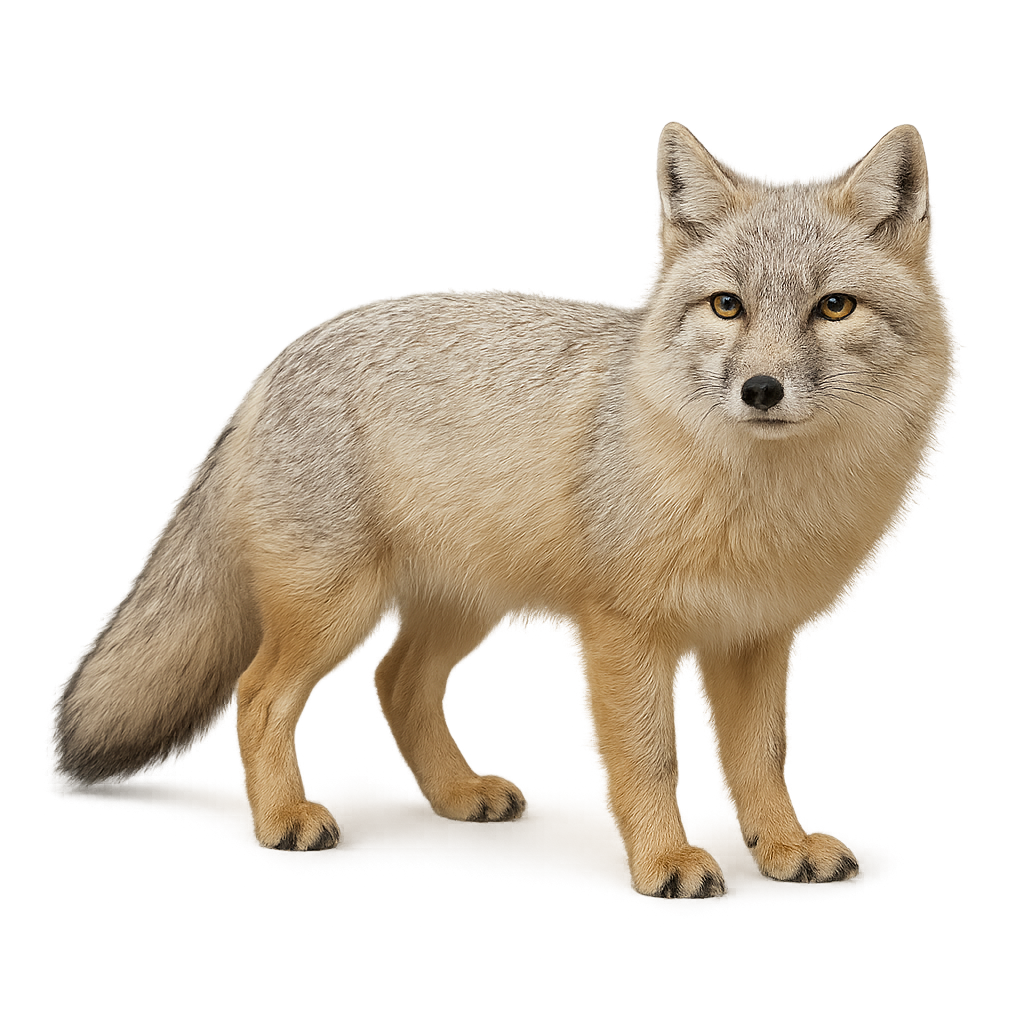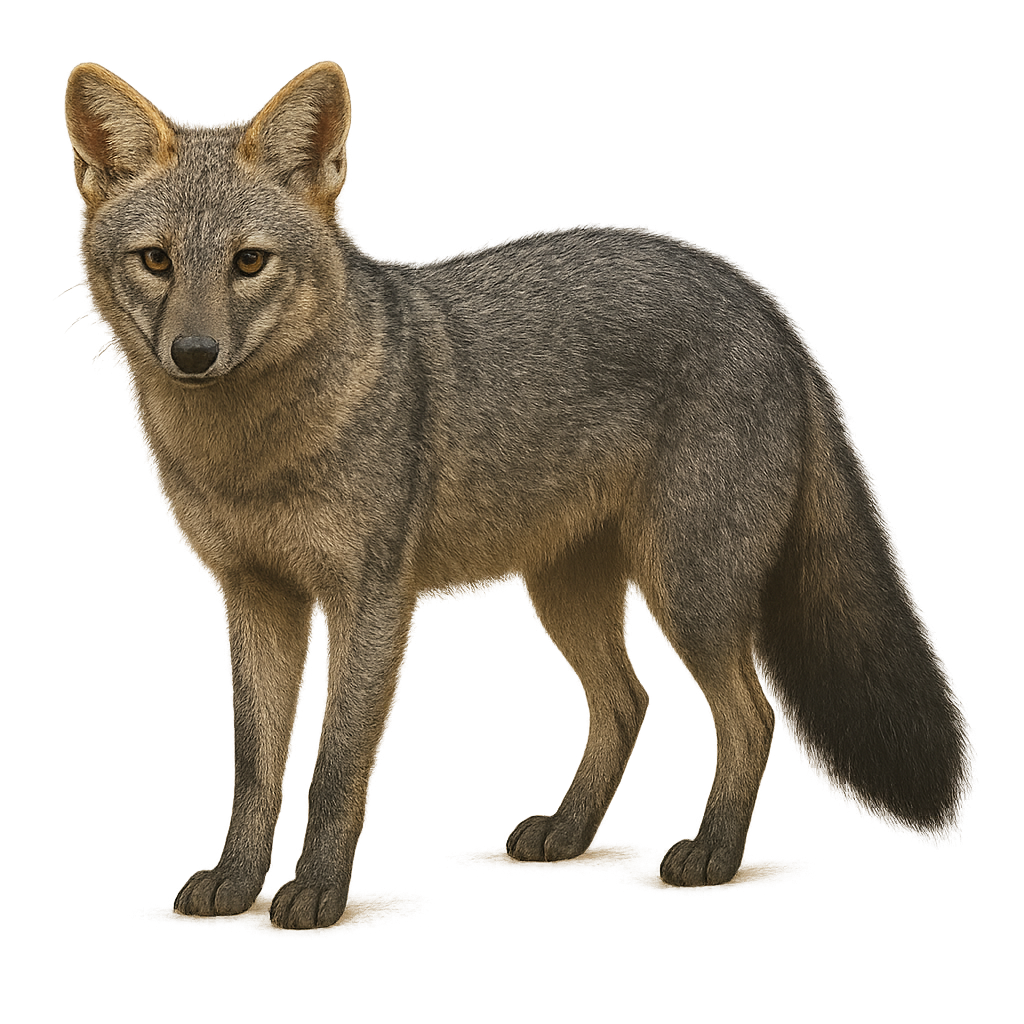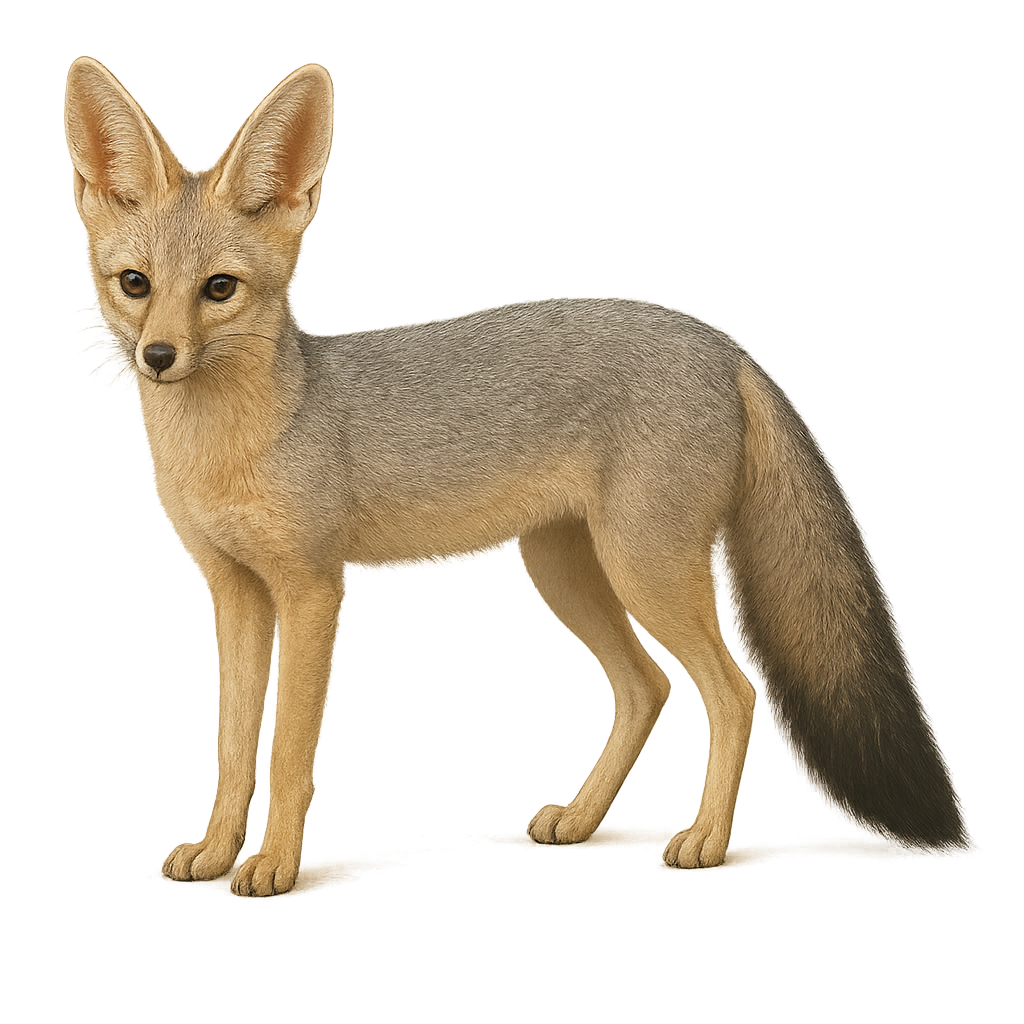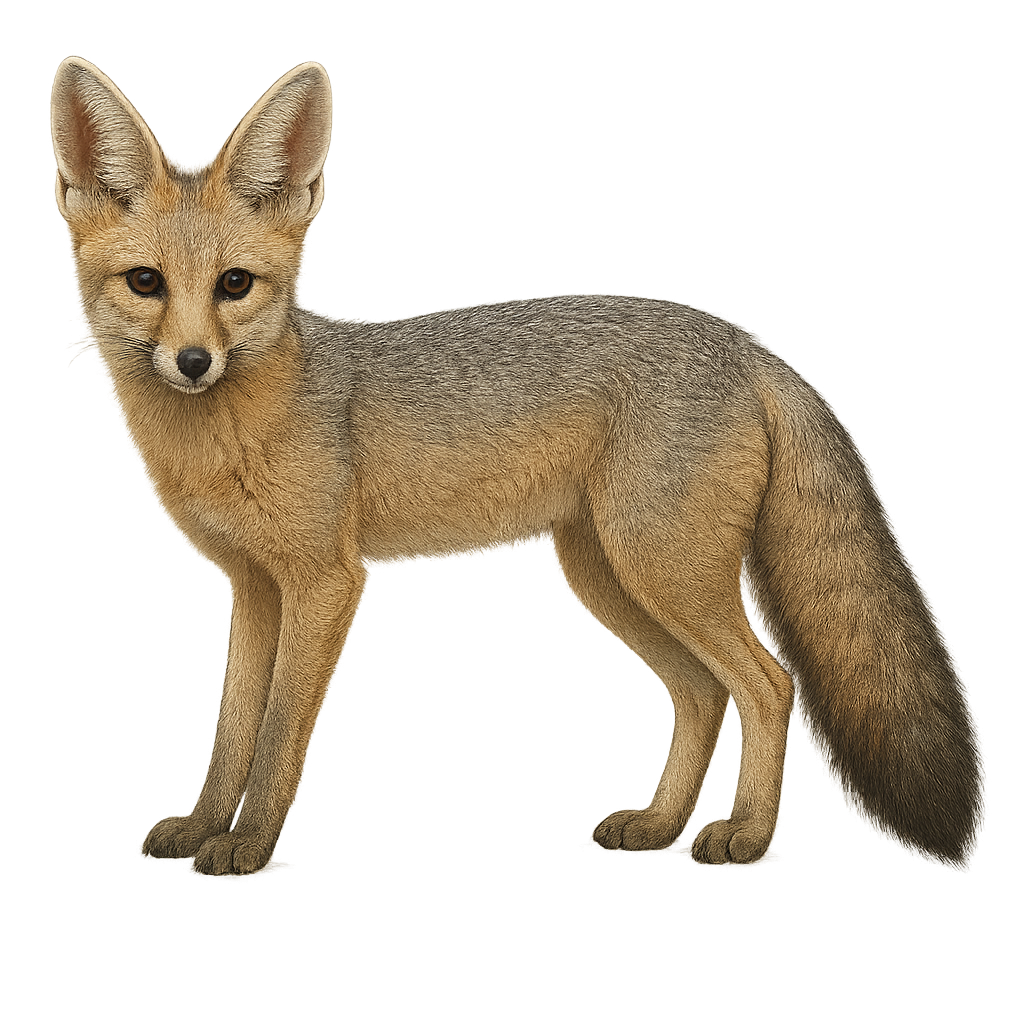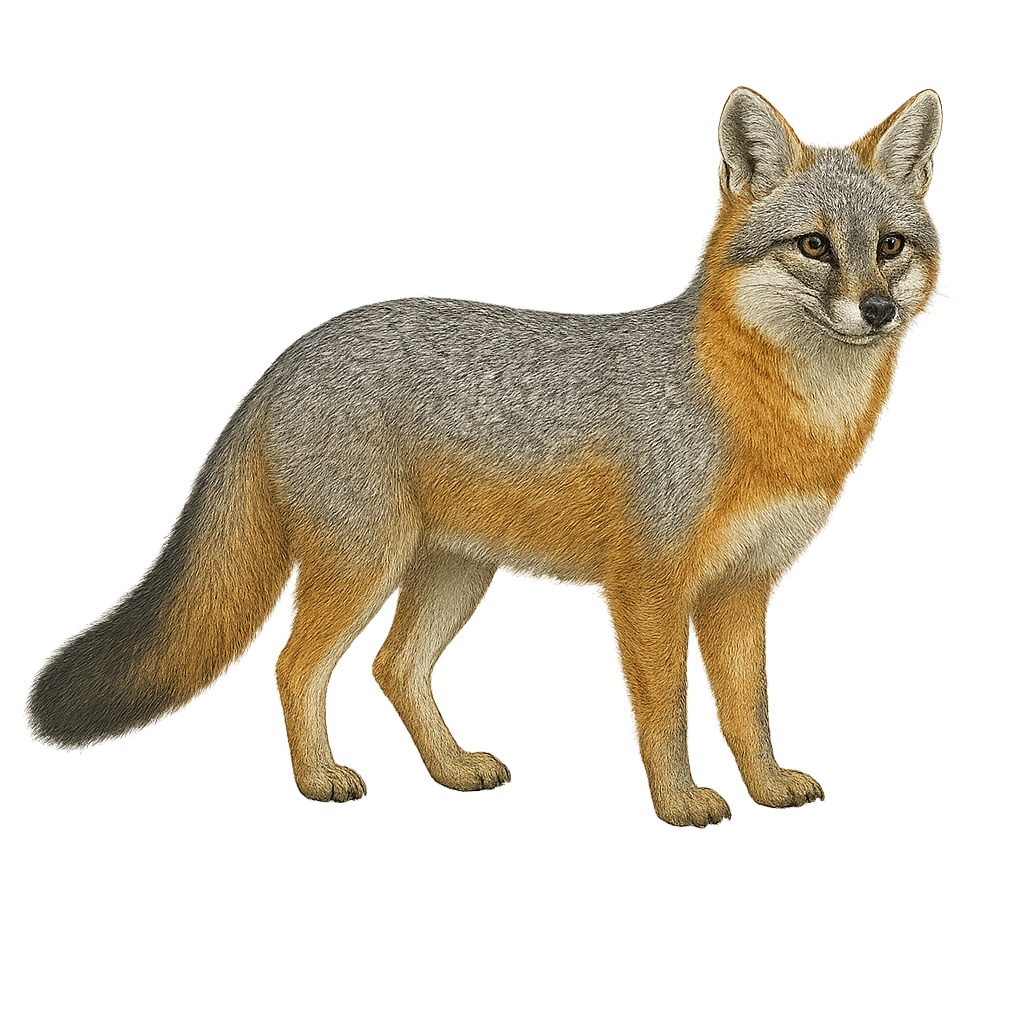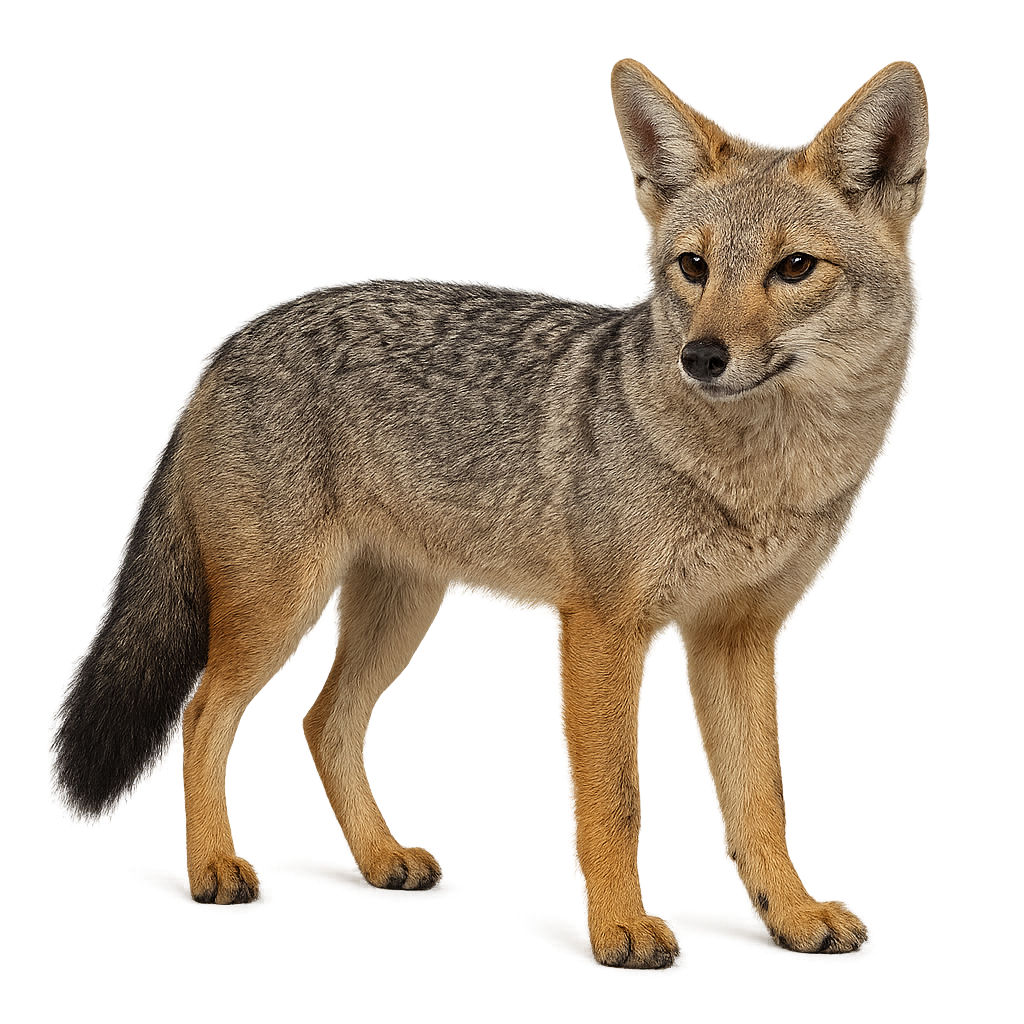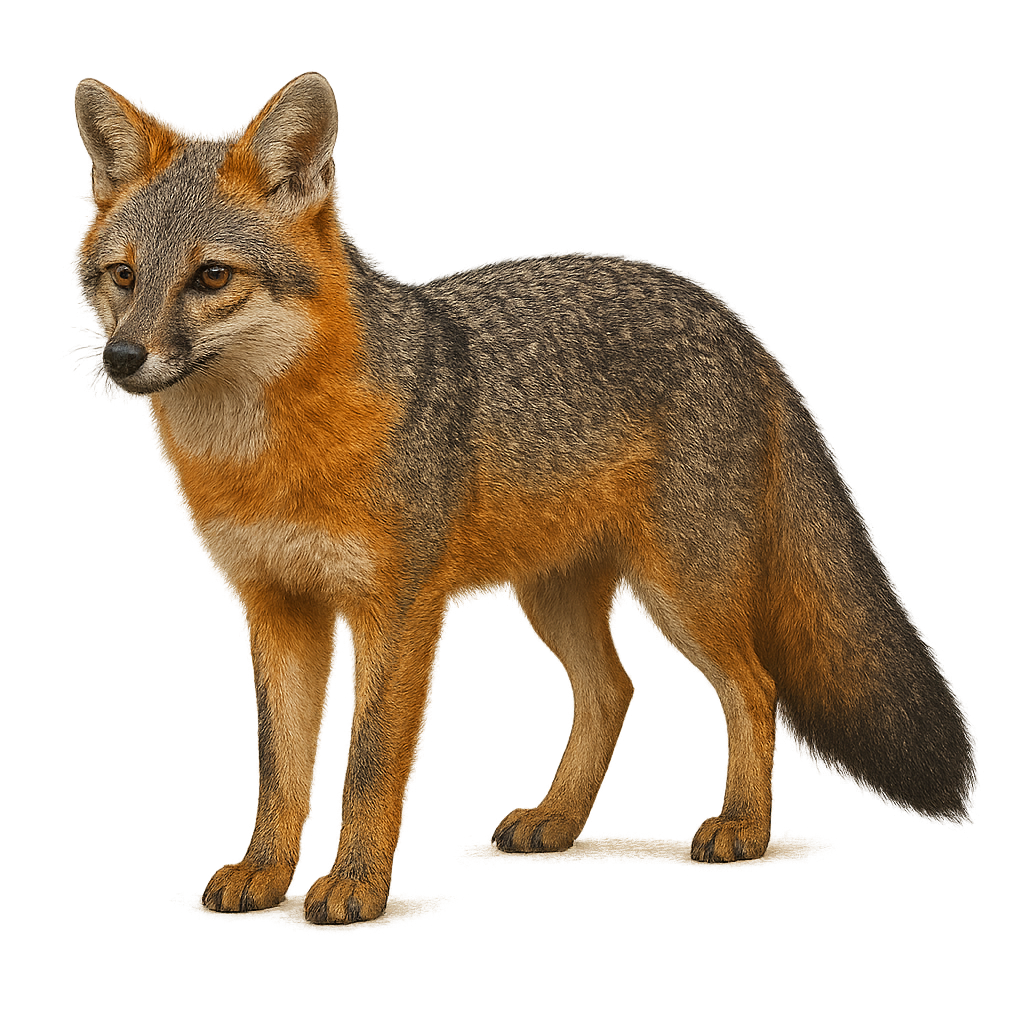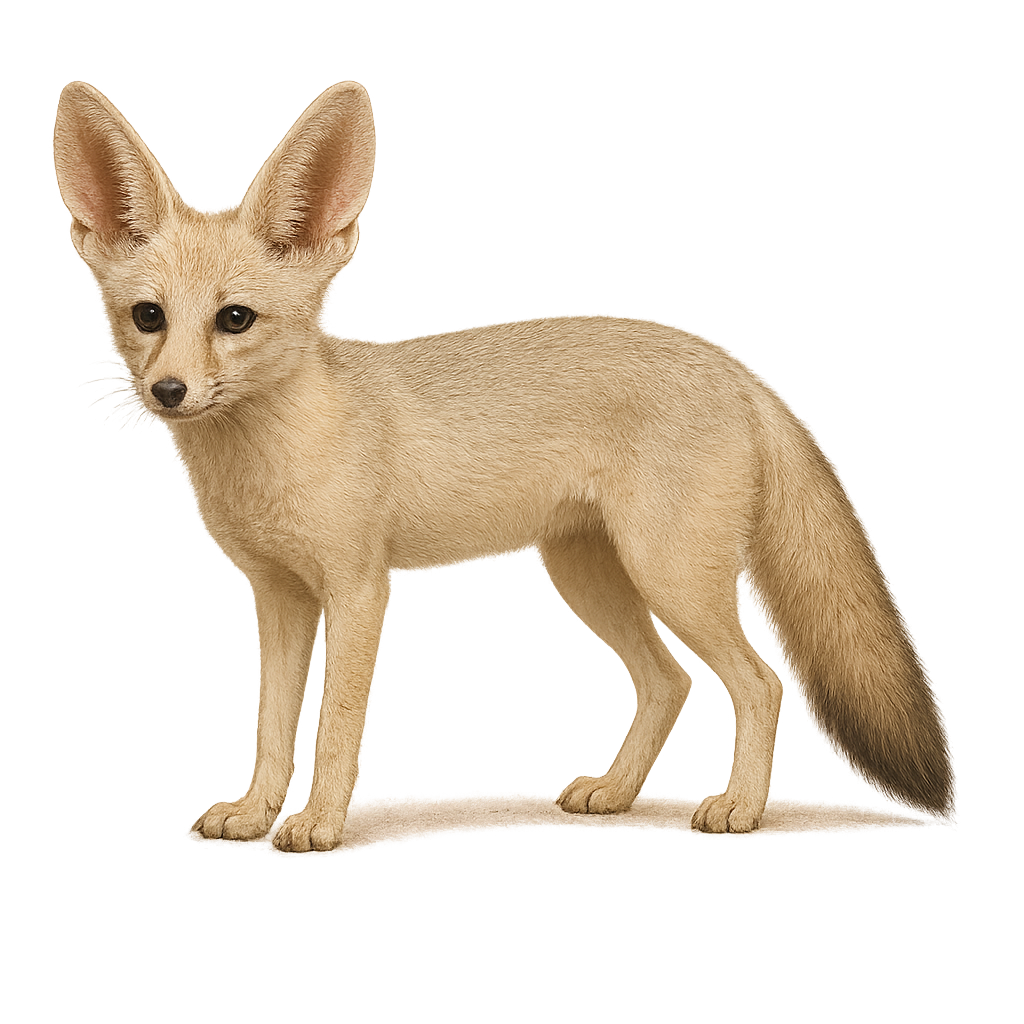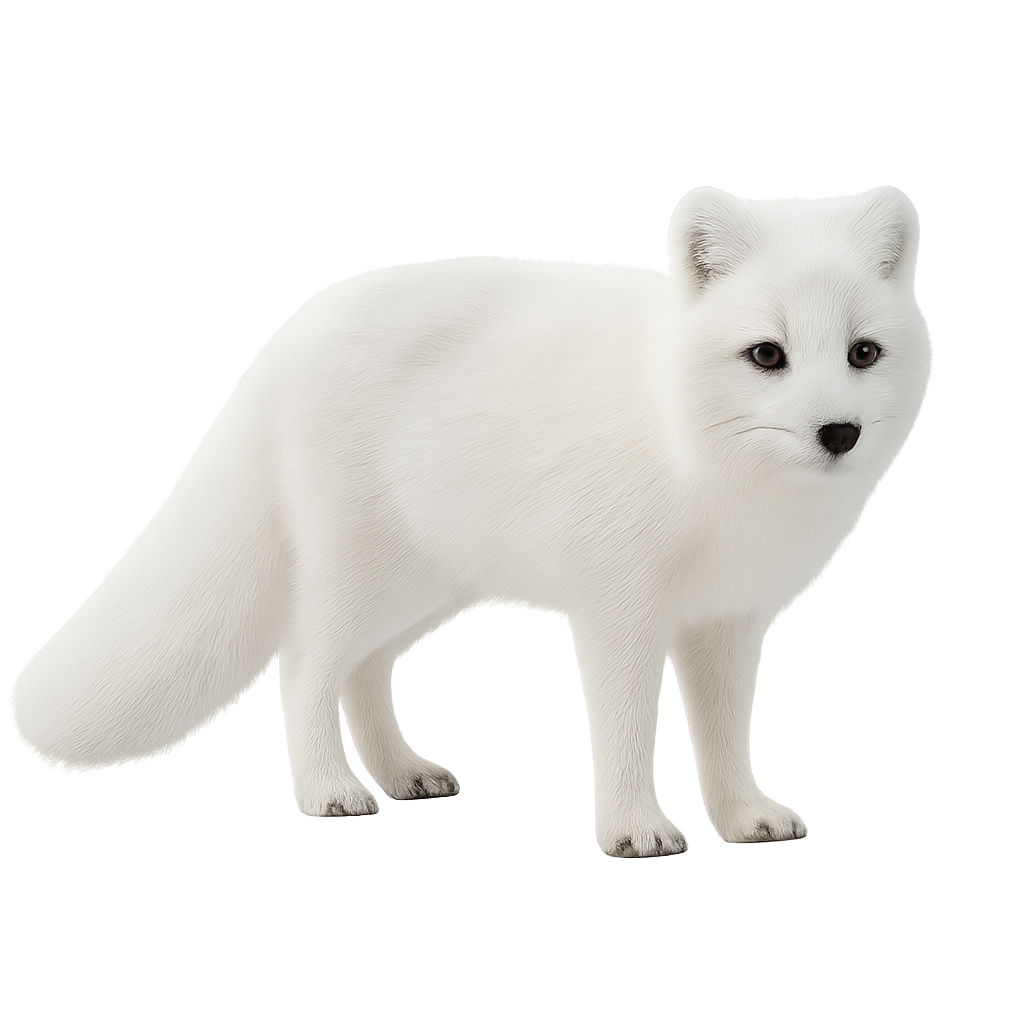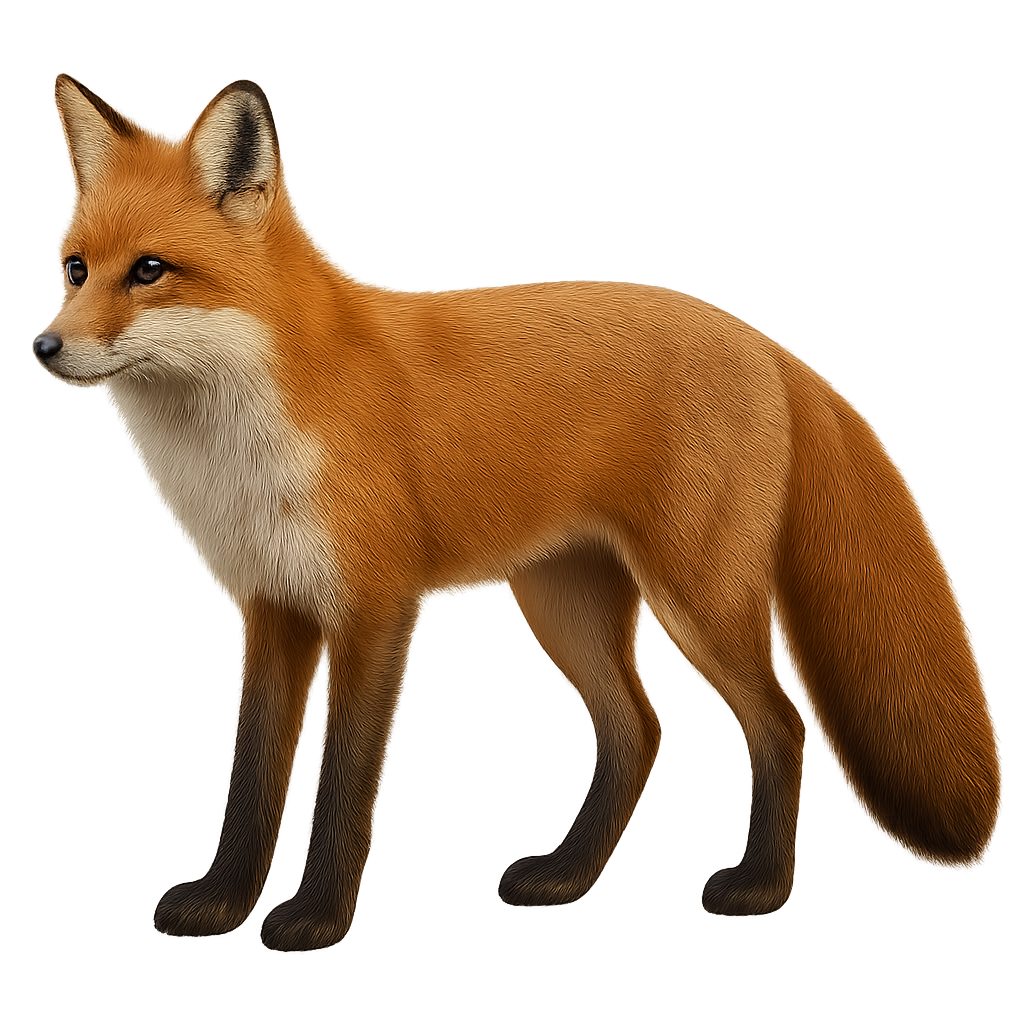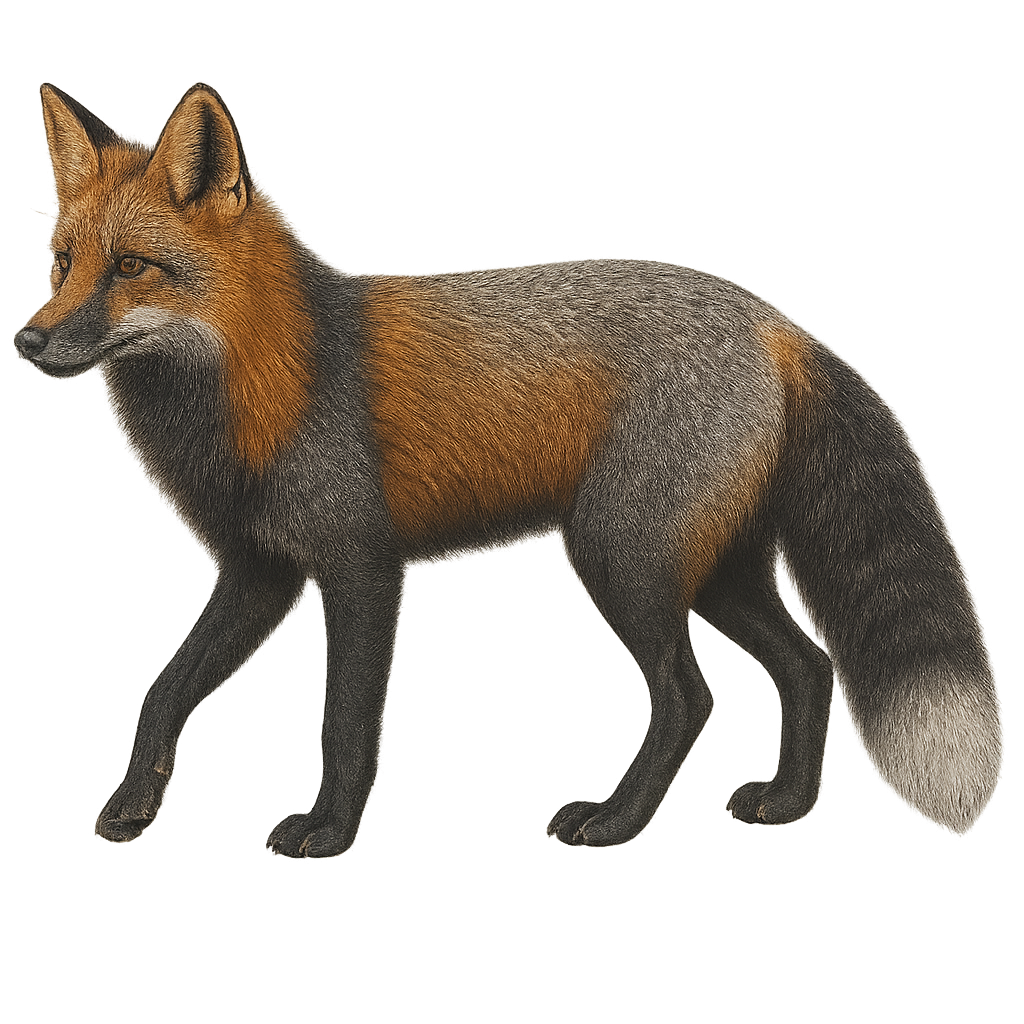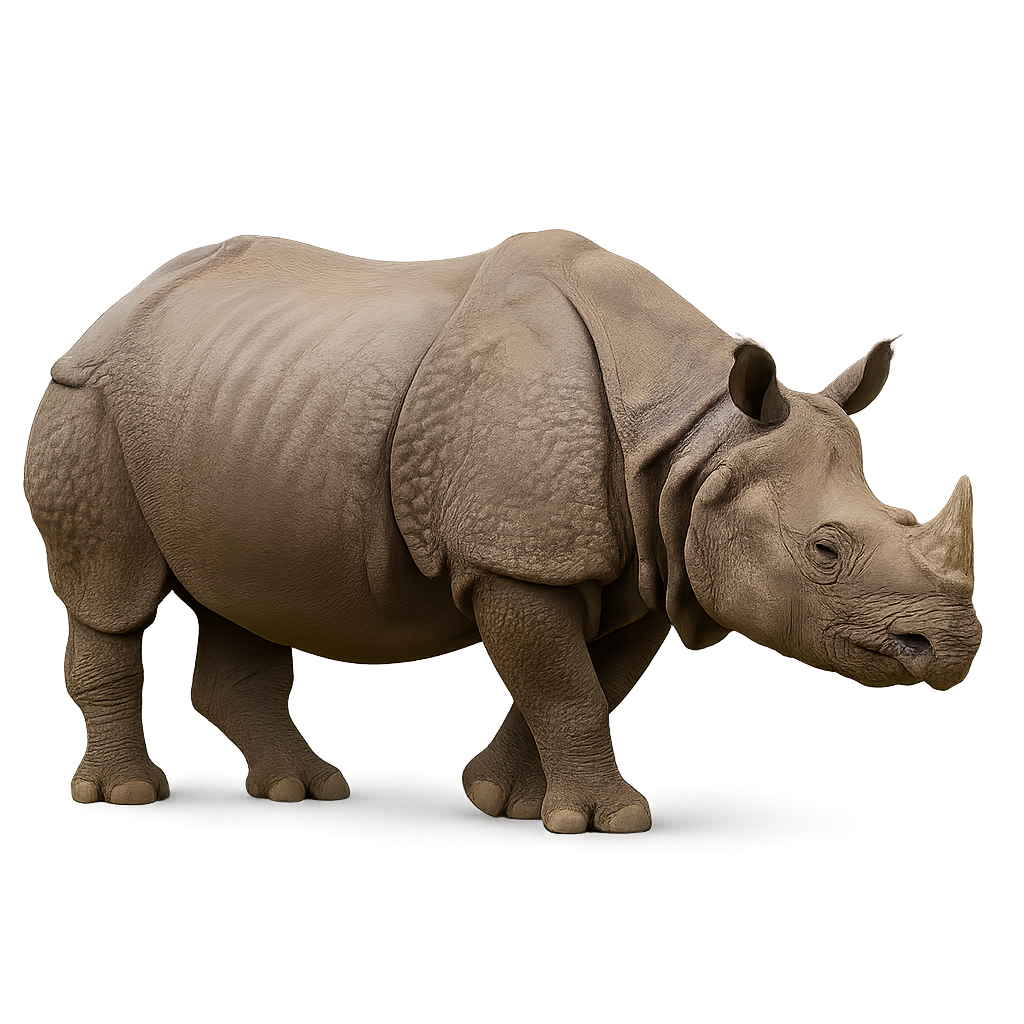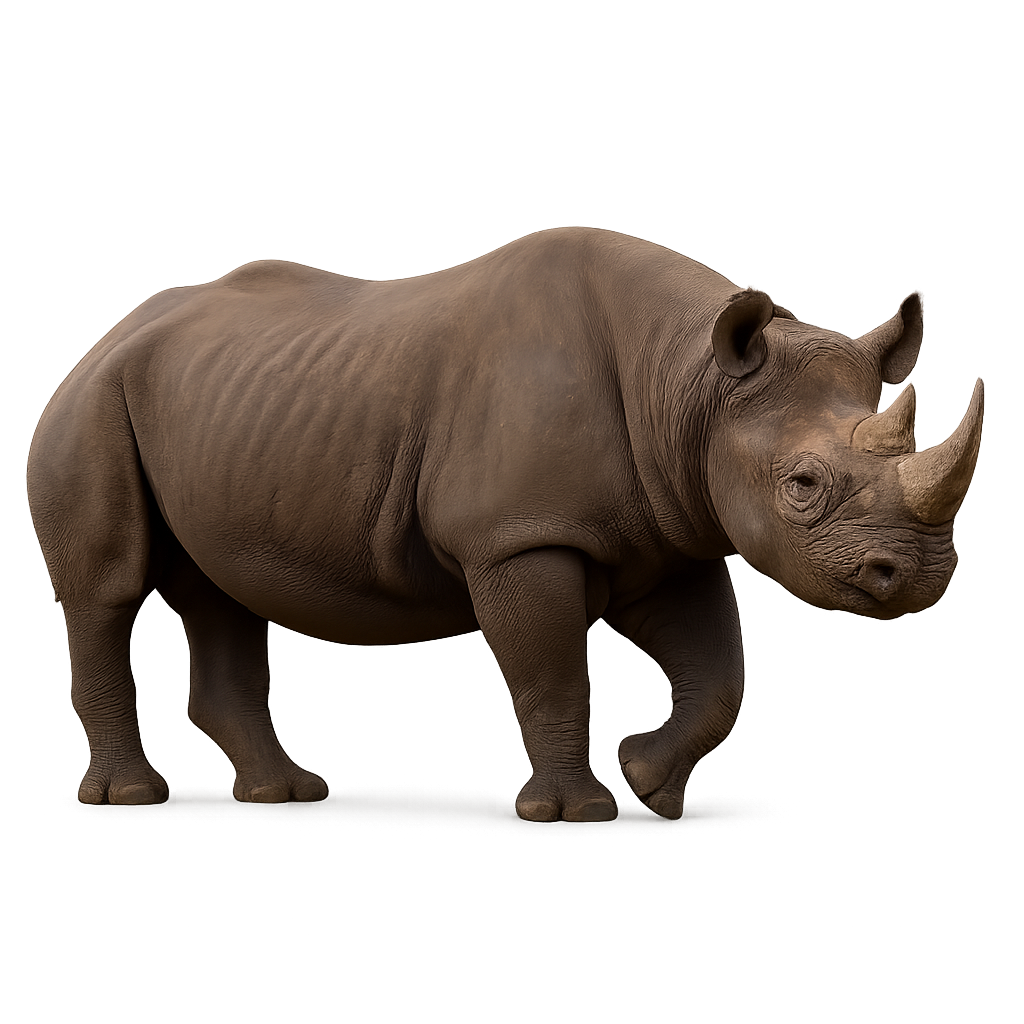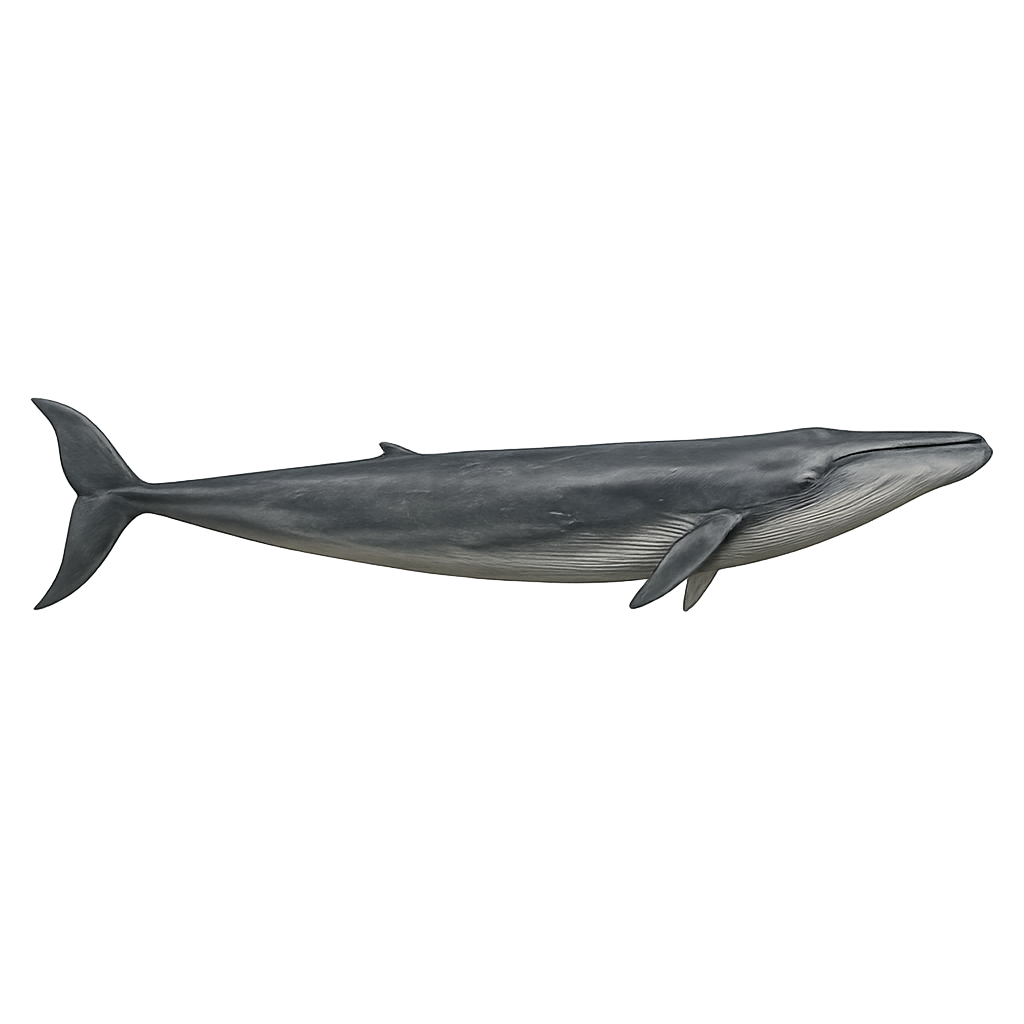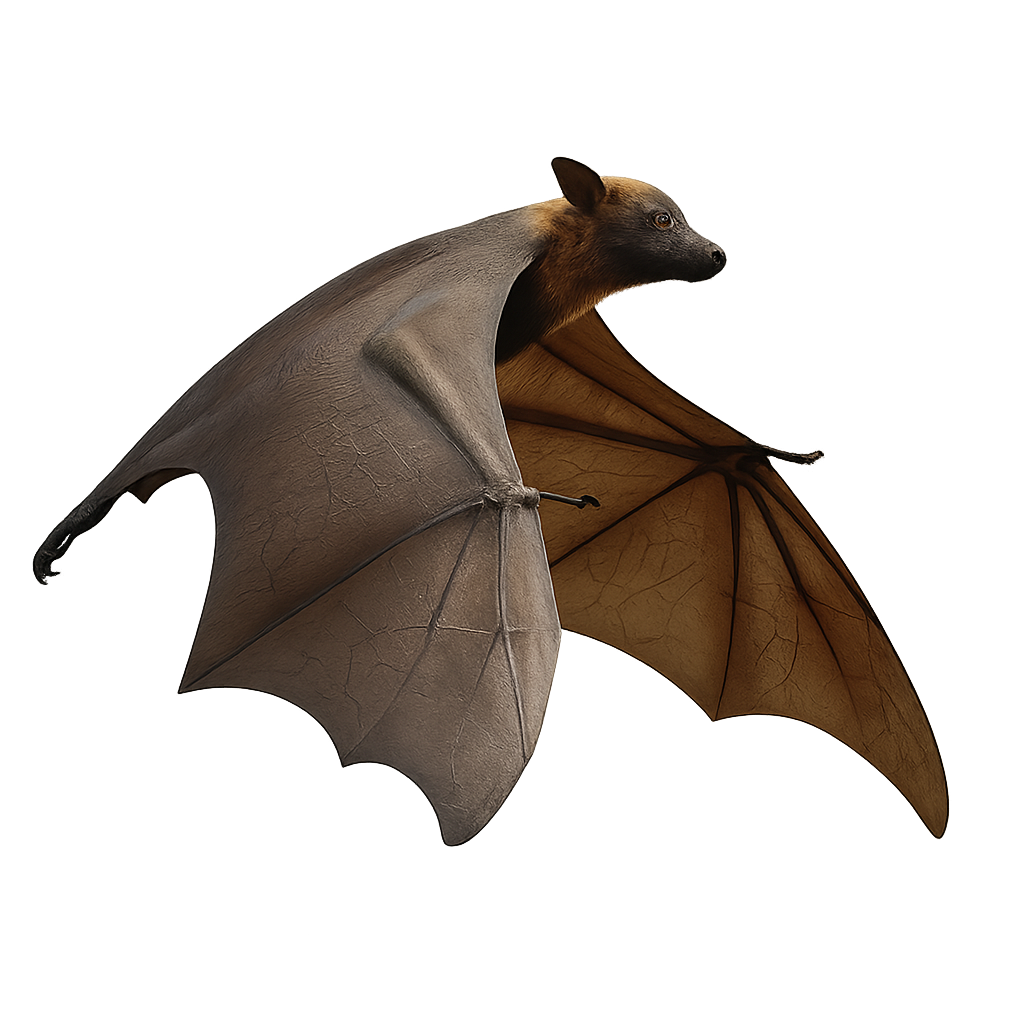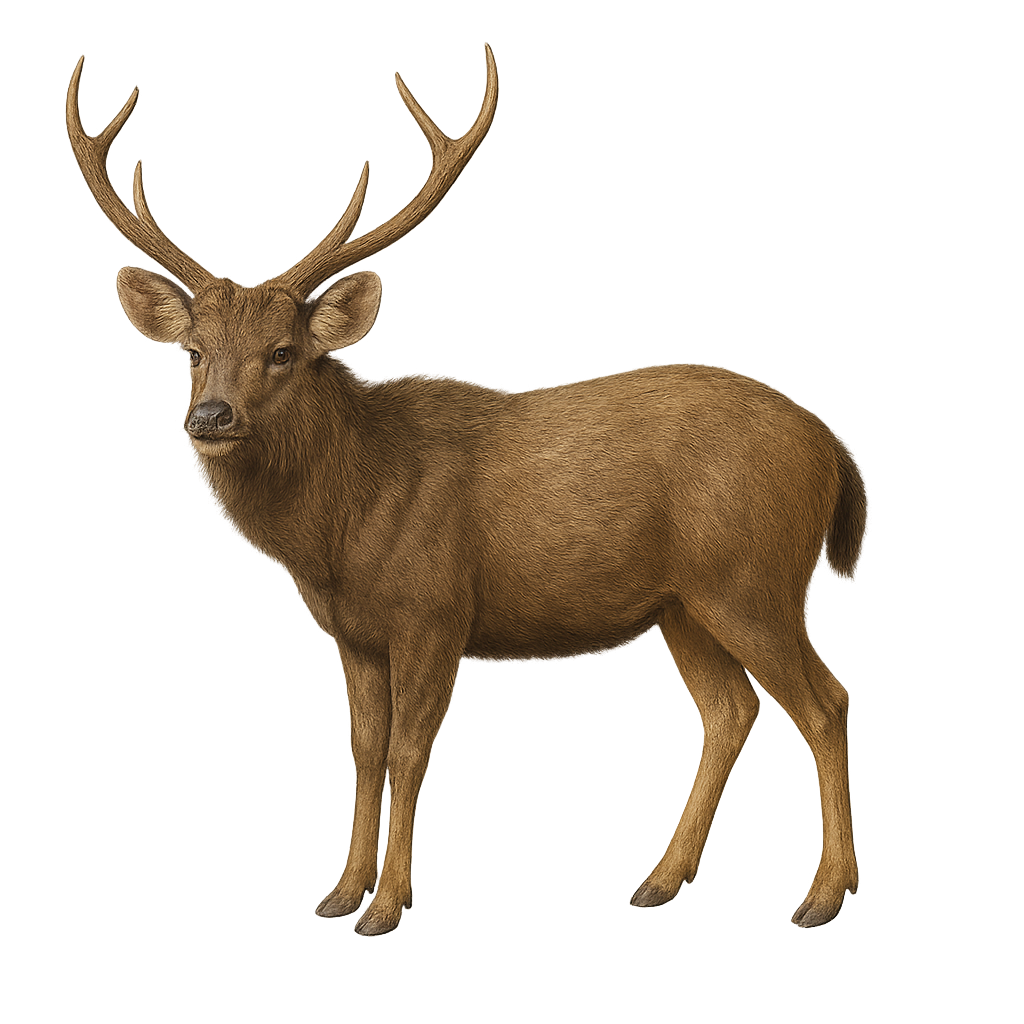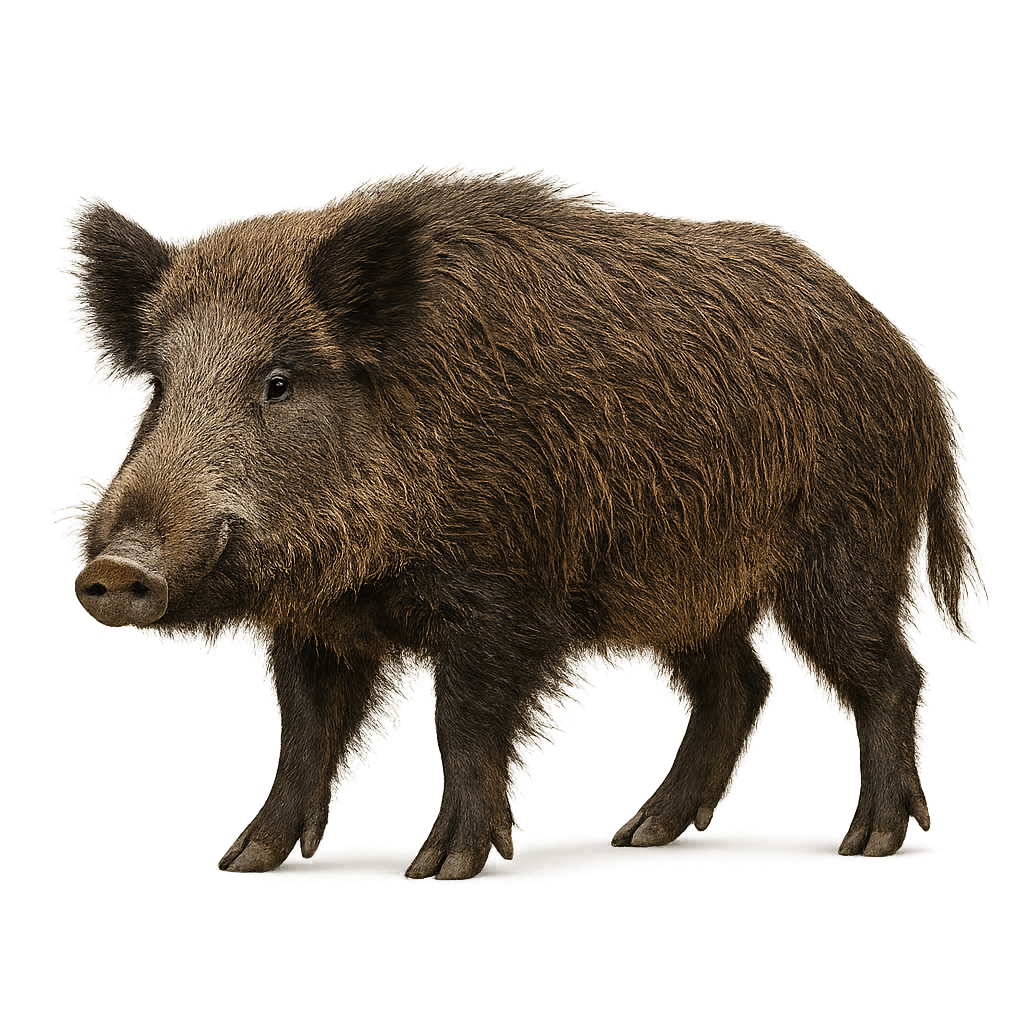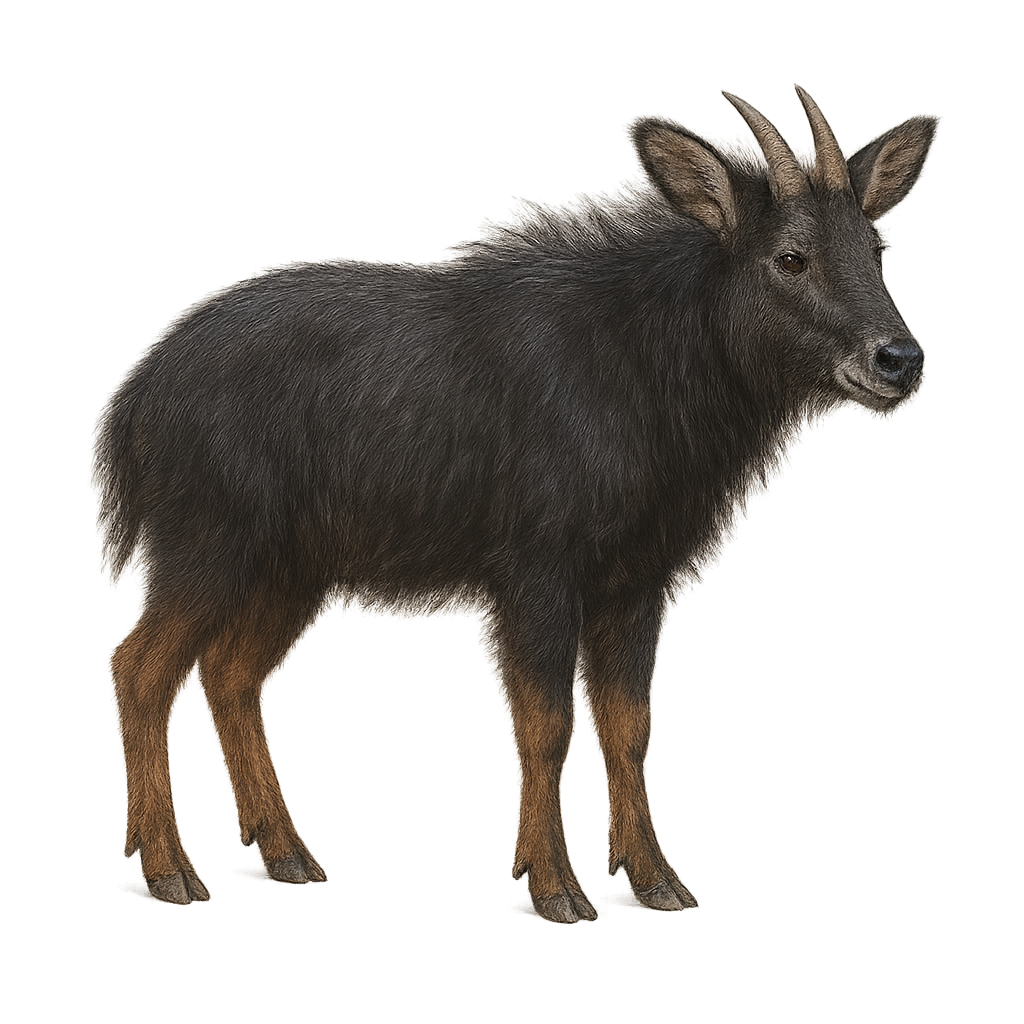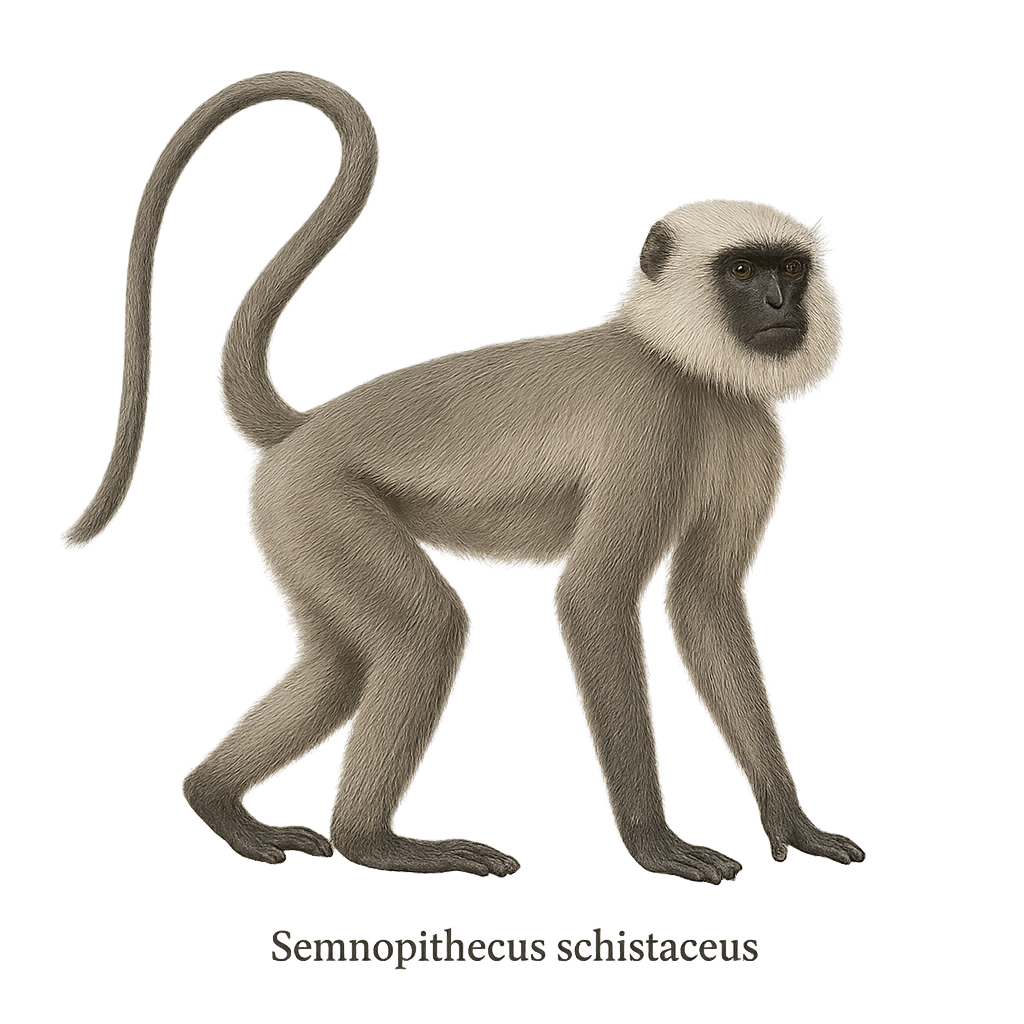The corsac fox is a small canid 40–50 cm in body length, with dense grey-fawn winter fur and paler summer coat. It inhabits steppes and semi-deserts of Central Asia, feeding on small mammals, insects and wild fruits. During the breeding season, pairs dig or reuse a den to raise 4–8 kits.
The crab-eating fox, or Cerdocyon thous, is a medium-sized canid, measuring about 60 to 70 cm in length with a bushy tail of about 30 cm. Its coat is generally gray with shades of brown and black, allowing it to blend into its natural environment. It is primarily nocturnal and crepuscular, feeding on a variety of foods, including fruits, insects, small mammals, and, as its name suggests, crabs. It is found in various habitats ranging from tropical forests to open savannas, mainly in South America. Although often solitary, it can form monogamous pairs during the breeding season.
The Blanford's fox, or Vulpes cana, is a small canid primarily inhabiting the arid and mountainous regions of the Middle East. It is distinguished by its modest size, measuring about 40 cm in length, with a bushy tail almost as long as its body. Its fur is generally gray with shades of brown, allowing it to blend into its rocky environment. This fox is mainly nocturnal, helping it avoid the high daytime temperatures. It is omnivorous, feeding on small mammals, insects, fruits, and occasionally carrion. Although relatively unknown, it plays a crucial role in its ecosystem by regulating prey populations and dispersing seeds.
The Magellanic Fox is a small carnivore primarily found in the cold and coastal regions of Argentina and Chile, particularly in the Patagonian region. It measures about 60 to 70 cm in length, with a tail of 30 to 35 cm, and weighs between 3 and 5 kg. Its fur is generally gray, with lighter underparts and brown or reddish patches on its back and legs. This fox is omnivorous, feeding on small mammals, birds, insects, but also fruits and plants. It is mainly active during dusk and night, and usually lives alone or in small family groups. While its population remains relatively stable, this species can be threatened by habitat loss and hunting.
The Rüppell's fox, or Vulpes rueppellii, is a small desert-dwelling canid found primarily in North Africa and the Middle East. It is characterized by its sandy-colored fur, which provides excellent camouflage in its arid habitat. Its large ears not only enhance its hearing but also help dissipate heat. This fox is nocturnal, avoiding the extreme daytime temperatures. It primarily feeds on small rodents, insects, and fruits. Adapted to harsh conditions, it can survive with minimal water, obtaining necessary moisture from its food. Its ability to dig deep burrows offers protection from heat and predators.
The Cape Fox, or Vulpes chama, is a small canid native to the arid and semi-arid regions of southern Africa. It is easily recognizable by its silver-gray fur, large pointed ears, and bushy tail. This fox is primarily nocturnal, allowing it to avoid the intense heat of the day. It feeds on a variety of foods, including insects, small mammals, fruits, and carrion. Although it is an opportunistic predator, it plays a crucial role in controlling rodent populations. The Cape Fox is generally solitary, except during the breeding season. It is well adapted to its environment, capable of surviving with little water, deriving necessary moisture from its food.
The gray fox, or Urocyon cinereoargenteus, is a medium-sized canid known for its silver-gray fur, reddish legs, and bushy tail. Unique among canids, it can climb trees, allowing it to escape predators and forage for food. It primarily inhabits dense forests, scrublands, and mountainous regions of North and Central America. An omnivore, it feeds on small mammals, birds, insects, and fruits. The gray fox is generally nocturnal and crepuscular, preferring to avoid humans. Although widely distributed, it is often elusive and difficult to spot.
The South American Gray Fox, or Lycalopex grisea, is a medium-sized canid native to South America. It is characterized by its silvery-gray fur, pointed ears, and bushy tail. This fox is well adapted to various environments, from arid plains to temperate forests. It is omnivorous, feeding on small mammals, birds, insects, and fruits. Although often solitary, it can be seen in small family groups. Its ability to adapt to different habitats and diets makes it a resilient species. However, it is sometimes threatened by hunting and habitat loss.
The Island Fox, Urocyon littoralis, is a small canid endemic to California's Channel Islands. Smaller than its mainland relative, the gray fox, it has a silver-gray coat with reddish and white hues. This fox is well adapted to its insular environment, feeding mainly on small mammals, insects, and fruits. Its reduced size is an example of insular dwarfism, a common adaptation for island-dwelling species. Although its population was threatened by introduced predators and diseases, conservation efforts have stabilized its numbers.
The Pale Fox, or Vulpes pallida, is a discreet canid primarily inhabiting the arid and semi-arid regions of West Africa. Its coat is a pale sandy color, allowing it to blend seamlessly into its desert surroundings. It is medium-sized, with a pointed snout and large ears that help dissipate heat and detect distant sounds. This fox is mainly nocturnal, avoiding the high daytime temperatures. It feeds on a variety of foods, from small mammals to insects and fruits. Although relatively unknown, the Pale Fox plays a crucial role in the ecosystem by controlling rodent and insect populations.
The Arctic Fox is a small carnivore found in the Arctic regions, primarily in Alaska, Canada, Scandinavia, and Russia. It measures about 45 to 50 cm in length, with a tail of 30 to 35 cm, and weighs between 3 and 9 kg, depending on the seasons. Its fur is typically white in winter, allowing it to camouflage in the snow, while it takes on a more brown or grayish hue in summer to blend in with the rocky and grassy landscapes. The Arctic Fox is an opportunistic omnivore, feeding on small mammals, birds, eggs, fruits, and berries. Although well adapted to the extreme living conditions of the Arctic, it is threatened by climate change, which is altering its natural habitat and the availability of its prey.
The Red Fox is a small carnivore primarily found in forests, meadows, and agricultural areas of Europe, Asia, and North America. It measures about 45 to 90 cm in length, with a tail of 30 to 50 cm, and weighs between 3 and 10 kg. Its fur is typically reddish with white underparts and on the legs, and its tail is bushy with a white tip. The Red Fox is an opportunistic and omnivorous animal, feeding on small mammals, birds, insects, fruits, and berries. It is primarily active at dusk and night. While its population remains relatively stable in many regions, it can be threatened by habitat loss, vehicle collisions, and diseases.
The Vulpes vulpes alascensis, or Alaskan Red Fox, is a subspecies of the red fox found primarily in coastal and interior regions of Alaska. This fox is well adapted to cold climates, with a dense and thick coat that protects it from extreme temperatures. Its fur ranges from bright red to dark brown, with a characteristic bushy tail. An opportunistic feeder, it preys on small mammals, birds, insects, and occasionally fruits. Although primarily nocturnal, it can be seen at dawn and dusk. The Alaskan Red Fox is a solitary animal, except during the breeding season. It is known for its intelligence and ability to adapt to various environments, allowing it to survive in harsh conditions.
The Southern White Rhinoceros is a large herbivorous mammal primarily found in the savannas and grasslands of Southern Africa, notably in South Africa, Botswana, Zimbabwe, and Namibia. It is one of the largest species of rhinoceros, measuring up to 4 meters in length and weighing between 1,500 and 2,400 kg. It is distinguished by its large square-shaped mouth, adapted for grazing, and its light gray to grayish skin. The Southern White Rhinoceros is a strict herbivore, primarily feeding on grass, though it may occasionally consume leaves and fruits. While its population has long been threatened by poaching and habitat loss, thanks to conservation efforts, its population has made a remarkable recovery and remains relatively stable.
The Javan Rhinoceros is a rare and critically endangered species of rhinoceros found primarily on the island of Java in Indonesia. It measures about 3 to 3.5 meters in length, with a tail of 60 to 80 cm, and weighs between 900 and 1,400 kg. Its fur is dark gray, with thick, wrinkled skin, and it has a single horn located on its nose. The Javan Rhinoceros is primarily herbivorous, feeding on fruits, leaves, shoots, and grass. It typically lives in tropical forests and swampy areas, where it hides in dense vegetation to avoid predators. It is threatened by habitat loss, illegal hunting, and habitat fragmentation, with only a very small remaining population, estimated at fewer than 75 individuals.
The Sumatran Rhinoceros is a critically endangered species of rhinoceros found primarily on the island of Sumatra in Indonesia. It measures about 2 to 3 meters in length, with a tail of 60 to 70 cm, and weighs between 500 and 800 kg. Its fur is generally light brown or reddish, with thick, wrinkled skin. This rhinoceros is one of the smallest members of the rhinoceros family and has two horns. The Sumatran Rhinoceros is herbivorous, feeding on leaves, fruits, roots, and shoots. It primarily lives in tropical lowland forests and swampy areas. While conservation efforts have been made to protect this species, it remains threatened by deforestation, poaching, and habitat loss, with a population estimated to be fewer than 80 individuals in the wild.
The Indian Rhinoceros, also known as the one-horned rhinoceros, is a large species of rhinoceros found primarily in the Indian subcontinent, particularly in India, Nepal, Bangladesh, and Bhutan. It measures about 3.5 to 4 meters in length, with a tail of 60 to 70 cm, and weighs between 2,200 and 3,000 kg. This rhinoceros is easily recognized by its thick, wrinkled skin, with a single horn located on its nose. It primarily feeds on grasses, leaves, and fruits, and lives in a variety of habitats, including grasslands, wetlands, and riverine forests. While its population has long been threatened by poaching and habitat loss, thanks to conservation efforts, the Indian Rhinoceros has experienced some recovery, but it remains vulnerable.
The Black Rhinoceros is a large species of rhinoceros primarily found in East and Southern Africa, notably in Kenya, Tanzania, Namibia, and South Africa. It measures about 3.5 to 4 meters in length, with a tail of 50 to 70 cm, and weighs between 800 and 1,400 kg. This rhinoceros is distinguished by its black skin (although some specimens may be gray) and its two horns located on its nose. Unlike the White Rhinoceros, it has a more pointed mouth, adapted for eating bushes and trees. The Black Rhinoceros is primarily herbivorous, feeding on leaves, fruits, twigs, and tree bark. While its population has long been threatened by poaching and habitat loss, conservation efforts have helped stabilize its population, although it remains critically endangered.
The Yunnan snub-nosed monkey (Rhinopithecus bieti) is a large arboreal primate measuring 74–83 cm in body length (excluding tail) and weighing 14–17 kg, distinguished by its striking black-and-white coat, pink lips and flattened nose lacking nasal bones. Endemic to the alpine coniferous and mixed forests of southwestern China at elevations between 3000 and 4500 m, it feeds mainly on tree lichens, supplemented by bamboo leaves, buds and occasional fruits. This dietary specialization and dense, insulating fur enable survival in subzero temperatures. Living in cohesive troops often exceeding 400 individuals, these monkeys exhibit synchronized group displays and vocal congregations that reinforce social bonds during long, harsh winters.
The Northern right whale fin is a large baleen whale that primarily lives in the cold waters of the Atlantic and Pacific Oceans. It is one of the largest cetaceans, characterized by its streamlined body and fast swimming. Unlike other whales, it prefers deeper waters and is less often observed near the coast. The Northern right whale fin is threatened by pollution, underwater noise, and ship collisions, and is classified as vulnerable due to past commercial whaling.
The Fin whale, also known as the Minke whale, is one of the largest whale species, reaching lengths of up to 18 meters and weighing 70 tons. It primarily feeds on krill and small fish, capturing them by filtering water. This migratory whale travels long distances between breeding and feeding areas and is found in all oceans worldwide. While the Fin whale is a protected species, it is still threatened by pollution, ship strikes, and illegal whaling.
The large flying fox is a large frugivorous bat with a wingspan up to 1.5 m and weight up to 1 kg. Its grey-brown fur, accented by a pale yellow collar, covers its elongated body and long muzzle. Endemic to Southeast Asia (Malaysia, Indonesia, Philippines, Thailand), it roosts in colonies in forests and coastal mangroves, feeding on fruits, nectar, and flowers. During the breeding season, males defend a small harem and mate between November and January, with a single pup born in March-April.
The African straw-coloured fruit bat is a fruit-eating bat species native to sub-Saharan Africa. This bat is easily recognizable by its golden or straw-colored fur, which helps it blend into the foliage during the day. The African straw-coloured fruit bats primarily feed on fruits, nectar, and pollen, playing a crucial role in pollinating plants. They form large colonies and are often seen in flight at dusk as they head out to search for food. These bats can also travel long distances, making them adaptable to a wide range of habitats.
The saiga is an antelope from the Central Asian steppes, recognizable by its prominent, trunk-like nose that filters dust and warms inhaled air. Adapted to arid environments, it migrates in large herds in search of pastures. Its population, once declining, shows signs of recovery due to conservation efforts.
The sambar, or Cervus unicolor, is a large deer native to South and Southeast Asia. It is recognizable by its dark brown coat and impressive antlers in males. Sambars primarily inhabit dense forests, grasslands, and swamps, feeding on leaves, fruits, and bark. They are generally solitary or live in small family groups. The sambar is a crepuscular animal, active mainly at dawn and dusk. Although hunted for its meat and antlers, it remains relatively widespread in its natural habitat. However, deforestation and overhunting threaten some local populations.
The Wild Boar is a large omnivorous mammal found primarily in forests, wooded areas, and mountains of Europe, Asia, and North Africa. It measures between 1.2 and 1.8 meters in length, with a tail of 15 to 25 cm, and weighs between 50 and 100 kg, though some specimens can reach up to 200 kg. Its fur is typically brown, with darker hair on the back and lighter on the sides. The Wild Boar is a nocturnal animal, primarily feeding on roots, fruits, seeds, insects, and small animals. While it is considered game, it can sometimes pose a threat to agricultural crops due to its tendency to root through the soil. This species is widely distributed, and its population remains relatively stable, although it is sometimes threatened by excessive hunting and habitat loss.
The Sus scrofa moupinensis, commonly known as the Tibetan wild boar, is a subspecies of wild boar found primarily in the mountainous regions of Central Asia. It is distinguished by its robustness and ability to adapt to various environments, ranging from dense forests to alpine meadows. Its coat is generally thicker and darker than that of other subspecies, allowing it to better withstand cold temperatures. Males have prominent tusks, which they use for defense and for digging in the ground in search of food. As an omnivore, its diet is varied and includes roots, tubers, fruits, and small animals.
Saola
Pseudoryx nghetinhensis
The Saola, also known as the 'Asian unicorn,' is one of the rarest and most mysterious mammals on the planet, first discovered in 1992 in the mountains of Vietnam and Laos. This critically endangered cervid has spiral horns and a stealthy gait. It lives in tropical mountain forests and primarily feeds on vegetation. Due to its elusive nature and inaccessible habitat, it is very difficult to observe. It is threatened by deforestation and poaching.
The Mainland Serow, Capricornis milneedwardsii, is a robust caprine found in the mountainous forests of Southeast Asia. It is characterized by its thick, dark coat, often black or dark brown, and its short, slightly curved horns. Adapted to rugged terrains, it is an excellent climber. Serows are generally solitary or live in small family groups. Their diet mainly consists of leaves, shoots, and grasses. Although elusive, the serow plays a crucial role in its ecosystem by aiding in seed dispersal. Unfortunately, it is threatened by hunting and habitat loss.
The Semnopithecus schistaceus, commonly known as the Himalayan Gray Langur, is an arboreal primate found mainly in the mountainous forests of the Himalayas. This monkey is easily recognizable by its silvery-gray fur and distinctive black face. It lives in complex social groups and primarily feeds on leaves, fruits, and flowers. Adapted to high altitudes, it can be observed up to 4000 meters. Although generally wary of humans, it can sometimes be seen near villages. Its population is threatened by deforestation and hunting, although conservation efforts are underway to protect its natural habitat.


